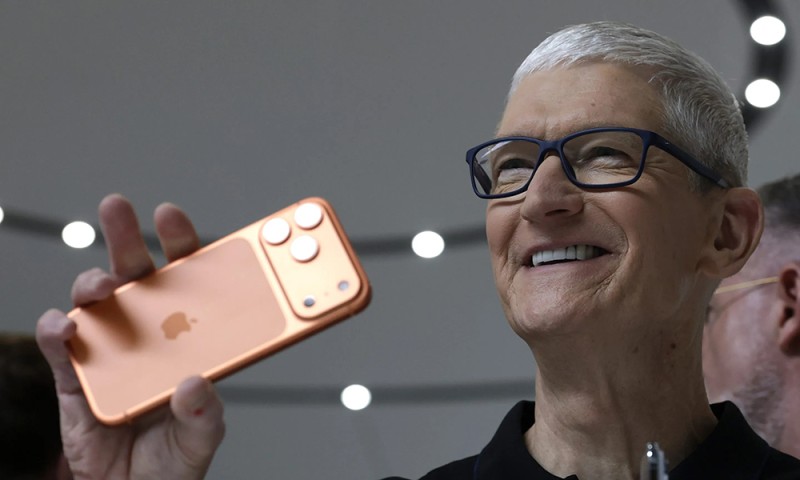
今年美国制造业岗位减少了3.3万个,但蒂姆·库克坚信自己已找到破局之策。
这位苹果首席执行官表示,公司近期宣布的6000亿美元美国建厂投资计划将引发“多米诺骨牌效应”,推动美国本土制造业蓬勃发展。
“我们难以做到覆盖所有地区。尽管内心十分渴望达成这一目标,但未来四年我们会投入6000亿美元来推进这项计划,”库克周一接受美国消费者新闻与商业频道(CNBC)主持人吉姆·克莱默(Jim Cramer)的电视采访时表示,“这是一项非同寻常的承诺。”
库克暗示,苹果未来四年在美国建造79家工厂的“非同寻常的承诺”,将吸引更多企业入驻工厂所在社区。
“这就是连锁效应,”库克表示,“会有更多企业跟进,这本质上就是多米诺骨牌效应。”
自2007年iPhone问世以来,苹果一直在美国境外生产该产品,其中绝大多数组装工作在中国富士康(Foxconn)的大型工厂完成。这家中国台湾跨国电子代工厂仅在位于郑州的工厂就雇佣了约35万名工人,日产iPhone高达50万部,有力推动了中国中部地区的经济增长。
目前美国市场销售的iPhone中,约80%产自中国。不过有报道称,苹果正将部分供应链转移至印度,以规避关税——涉及价值4.33亿美元的芯片交易。据路透社消息,今年3月,这家总部位于硅谷的科技公司通过印度工厂出货了价值20亿美元的iPhone,创下印度信息技术企业塔塔集团(Tata)与富士康的纪录。
半岛电视台(Al Jazeera)4月报道称,苹果曾计划在2026年底前,将美国市场所售多数iPhone的组装业务转移至美国本土。
如今库克正押注本届美国政府领导下的美国制造业复兴,还特别提及唐纳德·特朗普“推动更多制造业回流”的目标。
谈及投资者对建厂计划的态度时,库克表示:“我认为多数人看到这项投资都会说,‘你们在美国投资,这太棒了。’”
苹果对亚洲的依赖
尽管苹果承诺扩建美国工厂,但Info-Tech Research Group的顾问研究员斯科特·比克利(Scott Bickley)向《财富》杂志表示,受海外供应商高度集中、劳动力规模差异以及美国工人成本远高于海外劳动力等因素影响,这家科技巨头的制造中心仍将留在亚洲。
“在可预见的未来,这些因素都将支撑亚洲继续成为iPhone制造的核心区域。”比克利表示。
金融服务公司Gabelli Funds的投资组合经理约翰·贝尔顿(John Belton)向《财富》透露,苹果6000亿美元投资中的大部分,早已纳入公司长期财务规划。
“重构复杂供应链需要时间。”贝尔顿表示。
他补充称,苹果只会将盖板玻璃、部分芯片等特定零部件的生产迁回美国,而iPhone的最终组装工作仍将留在中国(印度会承接少量组装工作)。
“就苹果的全球业务而言,这应被视为渐进式调整,而非革命性变革。”贝尔顿说。
至于工厂建成后为当地社区带来更多制造业竞争,近期报告揭示了美国制造业革新面临的显著障碍:技术工人严重短缺。美国劳工统计局数据显示,目前约有40万制造业岗位处于空缺状态。
“如何组织大规模劳动力将零部件组装成成品iPhone,这仍是个难题。”Kandji(为企业提供苹果设备管理与安全保障的软件平台)资深解决方案工程师威尔登·多德(Weldon Dodd)向《财富》杂志表示,“很难想象,富士康在美国何处能找到拥有30万甚至更多可用劳动力的市场。”
不过,人工智能电商平台Sotira首席执行官阿姆丽塔·巴辛(Amrita Bhasin)向《财富》表示,若苹果能成功推进建厂计划,“将迫使美国其他科技或硬件企业投资'美国制造'模式”。
Laffer Tengler Investments高级证券分析师杰米·迈耶斯(Jamie Meyers)则指出,考虑到美国制造业劳动力短缺,以及苹果复杂的全球供应链(苹果从40多个国家的供应商处采购零部件和材料),要在美国本土复制这套体系“根本不可能”。但他也承认,苹果的建厂计划仍会创造新的制造业岗位。
“美国人是否愿意从事这些工作,则是另外一码事。”迈耶斯说。
他还表示,倘若苹果建厂计划确实能带来更多行业竞争,本质上也是对特朗普政府“推动本土制造业发展”政策的呼应。
“苹果进军美国制造业早有规划,如今之所以被大肆宣传,正是源于本届政府对本土制造业的立场,”迈耶斯表示,“我们认为,引发多米诺骨牌效应的并非苹果,而是对国内外政策的回应。”
苹果公司未立即回应《财富》杂志的置评请求。(*)
译者:中慧言-王芳
今年美国制造业岗位减少了3.3万个,但蒂姆·库克坚信自己已找到破局之策。
这位苹果首席执行官表示,公司近期宣布的6000亿美元美国建厂投资计划将引发“多米诺骨牌效应”,推动美国本土制造业蓬勃发展。
“我们难以做到覆盖所有地区。尽管内心十分渴望达成这一目标,但未来四年我们会投入6000亿美元来推进这项计划,”库克周一接受美国消费者新闻与商业频道(CNBC)主持人吉姆·克莱默(Jim Cramer)的电视采访时表示,“这是一项非同寻常的承诺。”
库克暗示,苹果未来四年在美国建造79家工厂的“非同寻常的承诺”,将吸引更多企业入驻工厂所在社区。
“这就是连锁效应,”库克表示,“会有更多企业跟进,这本质上就是多米诺骨牌效应。”
自2007年iPhone问世以来,苹果一直在美国境外生产该产品,其中绝大多数组装工作在中国富士康(Foxconn)的大型工厂完成。这家中国台湾跨国电子代工厂仅在位于郑州的工厂就雇佣了约35万名工人,日产iPhone高达50万部,有力推动了中国中部地区的经济增长。
目前美国市场销售的iPhone中,约80%产自中国。不过有报道称,苹果正将部分供应链转移至印度,以规避关税——涉及价值4.33亿美元的芯片交易。据路透社消息,今年3月,这家总部位于硅谷的科技公司通过印度工厂出货了价值20亿美元的iPhone,创下印度信息技术企业塔塔集团(Tata)与富士康的纪录。
半岛电视台(Al Jazeera)4月报道称,苹果曾计划在2026年底前,将美国市场所售多数iPhone的组装业务转移至美国本土。
如今库克正押注本届美国政府领导下的美国制造业复兴,还特别提及唐纳德·特朗普“推动更多制造业回流”的目标。
谈及投资者对建厂计划的态度时,库克表示:“我认为多数人看到这项投资都会说,‘你们在美国投资,这太棒了。’”
苹果对亚洲的依赖
尽管苹果承诺扩建美国工厂,但Info-Tech Research Group的顾问研究员斯科特·比克利(Scott Bickley)向《财富》杂志表示,受海外供应商高度集中、劳动力规模差异以及美国工人成本远高于海外劳动力等因素影响,这家科技巨头的制造中心仍将留在亚洲。
“在可预见的未来,这些因素都将支撑亚洲继续成为iPhone制造的核心区域。”比克利表示。
金融服务公司Gabelli Funds的投资组合经理约翰·贝尔顿(John Belton)向《财富》透露,苹果6000亿美元投资中的大部分,早已纳入公司长期财务规划。
“重构复杂供应链需要时间。”贝尔顿表示。
他补充称,苹果只会将盖板玻璃、部分芯片等特定零部件的生产迁回美国,而iPhone的最终组装工作仍将留在中国(印度会承接少量组装工作)。
“就苹果的全球业务而言,这应被视为渐进式调整,而非革命性变革。”贝尔顿说。
至于工厂建成后为当地社区带来更多制造业竞争,近期报告揭示了美国制造业革新面临的显著障碍:技术工人严重短缺。美国劳工统计局数据显示,目前约有40万制造业岗位处于空缺状态。
“如何组织大规模劳动力将零部件组装成成品iPhone,这仍是个难题。”Kandji(为企业提供苹果设备管理与安全保障的软件平台)资深解决方案工程师威尔登·多德(Weldon Dodd)向《财富》杂志表示,“很难想象,富士康在美国何处能找到拥有30万甚至更多可用劳动力的市场。”
不过,人工智能电商平台Sotira首席执行官阿姆丽塔·巴辛(Amrita Bhasin)向《财富》表示,若苹果能成功推进建厂计划,“将迫使美国其他科技或硬件企业投资'美国制造'模式”。
Laffer Tengler Investments高级证券分析师杰米·迈耶斯(Jamie Meyers)则指出,考虑到美国制造业劳动力短缺,以及苹果复杂的全球供应链(苹果从40多个国家的供应商处采购零部件和材料),要在美国本土复制这套体系“根本不可能”。但他也承认,苹果的建厂计划仍会创造新的制造业岗位。
“美国人是否愿意从事这些工作,则是另外一码事。”迈耶斯说。
他还表示,倘若苹果建厂计划确实能带来更多行业竞争,本质上也是对特朗普政府“推动本土制造业发展”政策的呼应。
“苹果进军美国制造业早有规划,如今之所以被大肆宣传,正是源于本届政府对本土制造业的立场,”迈耶斯表示,“我们认为,引发多米诺骨牌效应的并非苹果,而是对国内外政策的回应。”
苹果公司未立即回应《财富》杂志的置评请求。(*)
译者:中慧言-王芳
The U.S. has shed 33,000 manufacturing jobs this year—but Tim Cook believes he has a solution.
The Apple CEO said his company’s recent $600 billion investment to build factories across the U.S. will create a “domino effect,” boosting manufacturing in the country.
“We can’t be everywhere. I wish we could, but we are putting $600 billion to work in the next four years,” Cook told CNBC’s Jim Cramer during a TV interview on Monday. “And so it is an extraordinary commitment.”
Cook suggested Apple’s “extraordinary commitment” over the next four years to build 79 factories in the states could bring more businesses to the communities they are built in.
“That’s the ripple effect,” Cook said. “There will be more companies coming. It’s a domino effect kind of thing.”
Apple has manufactured iPhones outside the U.S. since the product’s inception in 2007, with the vast majority of assembly taking place in China at massive Foxconn facilities. Foxconn, a Taiwanese multinational electronics contract manufacturer, has a Zhengzhou plant that alone employs roughly 350,000 workers, produces up to 500,000 iPhones a day, and helps drive large-scale economic growth in central China.
Apple produces about 80% of the iPhones purchased in the U.S. in China, but has reportedly been shifting supply chains to India to avoid tariffs to the tune of a $433 million chip deal. The Silicon Valley-based tech company shipped $2 billion worth of iPhones in March, a record for both IT company Tata and Foxconn, according to Reuters.
Apple had plans to shift assembly of most of the iPhones it sells to the U.S. by the end of 2026, Al Jazeera reported in April.
Now, Cook is betting big on U.S. manufacturing under the current administration, noting President Donald Trump’s objective to get “more and more manufacturing” domestically.
“I think most people look at [the investment] and say, ‘It’s great that you’re investing in America,’” Cook said of investor sentiment to the planned factory build out.
Apple’s Asia dependence
Despite Apple’s pledge to build out factories, Scott Bickley, an advisory fellow at Info-Tech Research Group, told Fortune the tech giant’s manufacturing hub will remain in Asia, because of factors like the overseas supplier concentration, workforce scale, and how expensive U.S. workers are compared to offshore labor.
“[These factors] all favor Asia remaining the core of iPhone manufacturing for the foreseeable future,” Bickley said.
John Belton, portfolio manager at financial services firm Gabelli Funds, told Fortune most of Apple’s $600 billion investment was already reflected in the company’s long-range financial planning.
“Re-architecting a complex supply chain takes time,” Belton said.
Manufacturing of certain components like cover glass and some chips will be reshored, rather than final assembly of the phones, which will remain in China—and to a lesser extent India, Belton added.
“This should all be viewed as more evolutionary than revolutionary for Apple’s global operations,” Belton said.
As for the point of bringing more manufacturing competition to local communities once these factories are built, recent reports have uncovered a clear obstacle for an industry revamp: There just aren’t enough skilled workers anymore. About 400,000 manufacturing jobs are currently unfilled, according to the Bureau of Labor Statistics.
“There is still the problem of organizing the massive labor force required to assemble all those components into the finished iPhone,” Weldon Dodd, distinguished solutions engineer at Kandji, a software platform for managing and securing Apple devices for companies, told Fortune. “It’s difficult to imagine where in the U.S. Foxconn could find a market with 300,000 or more workers available to hire.”
Though, Amrita Bhasin, CEO of Sotira, an AI-powered e-commerce platform, told Fortune if Apple manages to pull off its build out, “it will put pressure on other tech or hardware companies in the U.S. to invest in the ‘made in America’ model.”
Jamie Meyers, senior securities analyst at Laffer Tengler Investments, told Fortune considering the manufacturing labor shortage and a complex global supply chain (Apple sources parts and materials from suppliers in over 40 countries), it would be impossible to replicate this domestically. However, the move will open up new manufacturing jobs.
“Whether Americans want those jobs is another question,” Meyers said.
And, if more competition comes from the factory build out, it will reflect the Trump administration’s push for domestic manufacturing, he said.
“Apple’s move into the United States was already planned and is now being touted because of the administration’s stance toward domestic manufacturing,” Meyers said. “We don’t think it’s Apple that will cause a domino effect, rather it is a response to domestic and international policies.”
Apple didn’t immediately respond to Fortune‘s request for comment.

